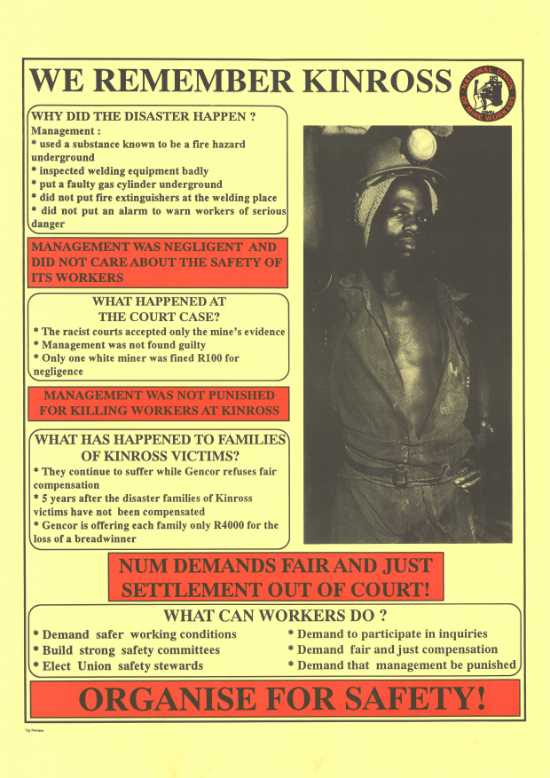"... (the miner's) work is so exaggeratedly awful, but also ... so vitally necessary and yet so remote from our experience, so invisible, as it were, that we are capable of forgetting it as we forget the blood in our veins."
- George Orwell, Down the Mine, The Road to Wigan Pier
On 13 October 2010, the National Union of Mineworkers (NUM) hosted a press conference to acknowledge and commemorate the hoisting of thirty three Chilean miners trapped underground for over two months at the San Jose Mine, Copiapo, Chile, north of the nation's capital, Santiago. This meeting also addressed other concerns related to the welfare of local miners, including the six week long strike by more than eight thousand miners at Northam Platinum.
The South African History Archive stands in solidarity with mineworkers in South Africa, and worldwide, in their long-standing struggle against exploitation, as well as the fight for improved occupational health and safety standards.

The Kinross mine disaster
In light of the phenomenal rescue mission of the Chilean workers, SAHA commemorates the plight of mineworkers, faced with one of the world's most dangerous and under-valued occupations. SAHA is in possession of two posters issued by the NUM during the Kinross mine disaster. Following this 16 September tragedy was one of the largest country-wide protests in the history of South Africa on 1 October 1986. Approximately three hundred thousand mine workers put down their tools in solidarity with the lives lost in the mine disaster at General Mining Union's Kinross gold mine in the Eastern Transvaal.
One hundred and seventy seven miners, nearly all of whom were black migrant workers, had been killed when a fire broke out during the Tuesday day shift. The accident took place after a welding team repairing a broken underground train track ignited an acetylene tank, which, in turn, ignited plastic coated wiring, producing noxious fumes which instantly asphyxiated workers who were exposed to the deadly chemicals released into the air.
National Union of Mineworkers (NUM) leader Cyril Ramaphosa argued that the tragedy revealed the fundamental inadequacy of safety standards in mines. It was not sufficient to blame human error; the overall schema of occupational safety had to consistently take the possibility of such mistakes into account. Rigiseal, the plastic foam cited as the cause of death, had already been banned in British mines, and was scheduled to be banned in Australia.
The accident is still regarded as one of the worst disasters in South African mining history. Other such tragedies include the 1960 Coalbrook Disaster, when 437 miners died, the 1995 Orkney Mine accident at the Vaal Reefs Mine where 105 died, the 1983 Hlobane Colliery disaster when 68 miners died, and the Trans Natal Corporation methane explosion where 39 miners were killed, to name a few.
Mortality rates often obscure the full impact of such dangers. Miners face the very real risk of disability or sickness owing to rock falls, methane exposure and silicosis, on a daily basis. In South Africa, it is the responsibility of the mining company to create, "as far as reasonably practicable, a work environment that is safe and without risk to the health of the workers." The rights of mine workers, and others, who encounter serious occupational hazards are laid out in the Occupational Health and Safety Act of 1993.
Learn more about mine safety in the South African Labour Guide.
 SAHA collections and mining
SAHA collections and mining
AL2446 :: The SAHA Poster Collection
This collection consists of over 4000 unique posters dating mostly from the 1980s-1990s. Duplicate copies of many of these posters exist. 327 posters from the collection have been reproduced in the book "Images of Defiance: South African Resistance Posters of the 1980s" by Ravan Press. A considerable number of posters also feature in the STP publication "Red on black: The story of the South African poster movement". Some of the posters are also available in slides (See AL2432) and digital format. The collection includes a large number of posters from the End Conscription Campaign (ECC), the United Democratic Front (UDF) and also includes posters relating to women, youth, AIDS, Congress of South African Trade Unions (Cosatu) as well Anti-Apartheid Movement (AAM) struggles.
AL2611 :: The Workers' Organisation for Socialist Action (WOSA) Collection
The Workers' Organisation for Socialist Action (WOSA) was launched in April 1990 as a national organisation. It is opposed to racism, tribalism and sexism and supports Socialism, leadership of the black working class, accountability and democracy. It was felt that an organisation was needed that could raise workers' issues without being aligned to any political parties (the example of the African National Congress (ANC)/South African Communist Party (SACP) Alliance was used). The issues that WOSA deals with relate to working conditions, wages, unemployment, housing, education, health and transport. This collection includes documents on National Conferences, copies of Workers' Voice, Vukani Basebenzi and pamphlets about the Workers' List Party.






 SAHA collections and mining
SAHA collections and mining